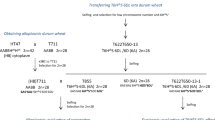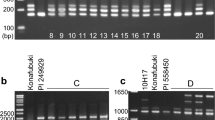Summary
Nuclei from Triticum aestivum L. cultivars ‘Penjamo 62’ and ‘Siete Cerros 66’ were introduced into the cytoplasms of different species of Aegilops and some subspecies (varieties) of T. dicoccoides by backcrossing. The sterile alloplasmic lines obtained were compared with the normal cultivars used as the recurrent pollen parents. According to the cytoplasmic effect, these cytoplasms were subdivided into three main groups. The first group possesses Cu type cytoplasm, the second one possesses M type and the third group includes S, C and G type. Promising male sterile cytoplasms for hybrid wheat production were found in Ae. mutica, Ae. triuncialis and T. dicoccoides var. ‘spontaneovillosum’. Based on these results and other information some conjectures were made concerning hybrid wheat breeding and phylogenetic differentiations of the cytoplasm.
Similar content being viewed by others
Literature
Chennaveeraiah, M.S.: Karyomorphologic and cytotaxonomic studies in Aegilops. Acta Horti Gotoburgensis 23, 85–178 (1960)
Endo, T.; Tsunewaki, K.: Sterility of common wheat with Aegilops triuncialis cytoplasm. J. Hered. 66, 13–18 (1975a)
Endo, T.; Tsunewaki, K.: Genetic diversity of the cytoplasm in Triticum and Aegilops. I. On the origin of the cytoplasm of Ae. triuncialis. Seiken Ziho 25–26, 55–66 (1975b)
Fukasawa, H.: Results of genome exchange among Aegilops and Triticum species through the successive backcrosses. Wheat Inf. Serv. 7, 24 (1958)
Fukasawa, H.: Nucleus substitution and restoration by means of successive backcrosses in wheat and its related genus Aegilops. Jap. J. Bot. 17, 55–91 (1959)
Hori, T.; Tsunewaki, K.: Study on substitution lines of several Emmer wheats having the cytoplasm of Triticum boeoticum. Seiken Ziho 19, 55–59 (1967)
Hori, T.; Tsunewaki, K.: Basic studies on hybrid wheat breeding. II. Effects of three alien cytoplasms on main quantitative characters of hexaploid wheats. Jap. J. Breed. 19, 425–430 (1969)
Kihara, H.: Cytologische und genetische Studien bei wichtigen Getreide-Arten mit besonderer Rucksicht auf das Verhalten der Chromosomes und die Sterilitat in den Bastarden. Mem. Coll. Sci. Kyoto Imp. Univ. Ser. B 1, 1–200 (1924)
Kihara, H.: Substitution of nucleus and its effects on genome manifestation. Cytologia 16, 177–193 (1951)
Kihara, H.: Factors affecting the evolution of common wheat. Ind. J. Genet. Plant Breed. 26A, 14–28 (1966)
Maan, S.S.: Cytoplasmic variability in Triticinae. Proc. 4th Int. Wheat Genet. Symp., Columbia, Mo., USA, 367–373 (1973)
Maan, S.S.: Cytoplasmic variability and speciation in Triticinae. In: Prairie: A Multiple View (Ed. Wali, M.K.), 255–281. N. Dak. Press 1975
Maan, S.S.: Cytoplasmic control of cross-incompatibility and zygotic and sporophytic sterility in interspecific hybrids. 8th Eucarpia Congr., Madrid, Spain (1977)
Maan, S.S.: Lucken, K.A.: Additional cytoplasmic male sterilityfertility restoration systems in Triticum. Wheat Inf. Serv. 23–24, 6–9 (1967)
Maan, S.S.: Lucken, K.A.: Interaction of Triticum boeoticum cytoplasm and genomes of T. aestivum: Restoration of male fertility and plant vigor. Euphytica 19, 498–508 (1970)
Maan, S.S.; Lucken, K.A.: Nucleo-cytoplasmic interactions involving Aegilops cytoplasms and Triticum genomes. J. Hered. 62, 149–152 (1971a)
Maan, S.S.; Lucken, K.A.: Male-sterile wheat with rye cytoplasm. J. Hered. 62, 353–355 (1971b)
Maan, S.S.; Lucken, K.A.: Interacting male sterility-male fertility restoration systems for hybrid wheat research. Crop Sci. 12, 360–364 (1972)
Maan, S.S.; Sasakuma, T.: Fertility of amphihaploids in Triticinae. J. Hered. 68, 87–94 (1977)
Milohnic, J.: Effect of cytoplasmic male sterility on the quality of seed in wheat. Poljopr. Znanstvena Smotra (Zagreb) 38 (48), 27–38 (1976)
Mukai, Y.; Tsunewaki, K.: Genetic diversity of the cytoplasm in Triticum and Aegilops. 2. Comparison of the cytoplasms between four 4x Aegilops Polyeides species and their 2x relatives. Seiken Ziho 25–26, 67–78 (1975)
Mukai, Y.; Maan, S.S.; Panayotov, I.; Tsunewaki, K.: Comparative studies of the nucleus-cytoplasm hybrids of wheat produced by three research groups. Proc. 5th Int. Wheat Genet. Symp., Delhi, India, 282–292 (1978)
Muramatsu, M.: Substitution of wheat nucleus into Aegilops umbellulata cytoplasm by the backcross method. Jap. J. Genet. 40, 406 (1965)
Nettevich, E.D.; Fedorova, T.N.: Availability of CMS factors in hexaploid T. zhukovskyi Men. and octaploid T. timonovum Heslot. Genetiks (Moscow) 5, 82–84 (1966)
Panayotov, I.; Gotsov, K.: Results of nucleus substitution in Aegilops and Triticum species by means of successive backcrosses with common wheat. Wheat Inf. Serv. 40, 20–22 (1975)
Panayotov, I.; Gotsov, K.: Interactions between Aegilops cytoplasms and Triticum genomes and evolution of Aegilops. Cereal Res. Commun. 4, 297–306 (1976)
Popov, P.; Panayotov, I.; Gotsov, K.: Nuclear cytoplasmic interrelations in the subtribe Triticinae. Influence of the cytoplasm on the phenotypic expression in wheat. Genet. Plant Breed. (Sofia) 9, 77–92 (1976)
Schmidt, J.W.; Johnson, V.A.; Maan, S.S.: Hybrid wheat. Nebraska Agr. Exp. Stat. Quarterly 3, 9–10 (1962)
Suemoto, H.: The origin of the cytoplasm of tetraploid wheats. Proc. 4th Int. Wheat Genet. Symp., Columbia, Mo., USA, 109–113 (1973)
Tanaka, M.; Ichikawa, S.: Cytogenetical relationships of two types of Triticum araraticum Jakubz. to other tetraploid wheat species. Jap. J. Genet. 47, 103–114 (1972)
Tsunewaki, K.: Monosomic analysis of two restores to Ae. caudata and Ae. umbellulata cytoplasms. Jap. J. Genet. 49, 425–433 (1974)
Tsunewaki, K.; Mukai, Y.; Endo, T.R.; Tsuji, S.; Murata, M.: Genetic diversity of the cytoplasm in Triticum and Aegilops. V. Classification of 23 cytoplasms into eight plasma types. Jap. J. Genet. 51, 175–191 (1976)
Wagenaar, E.B.: Studies on the genome constitution of Triticum timopheevi Zhuk. II. The T. timopheevi complex and its origin. Evolution 20, 150–164 (1966)
Wilson, J.A.; Ross, W.M.: Male-sterility interaction of Triticum aestivum nucleus and Triticum timopheevi cytoplasm. Wheat Inf. Serv. 14, 29–31 (1962)
Author information
Authors and Affiliations
Additional information
Communicated by K. Tsunewaki
Rights and permissions
About this article
Cite this article
Panayotov, I. New cytoplasmic male sterility sources in common wheat: Their genetical and breeding considerations. Theoret. Appl. Genetics 56, 153–160 (1980). https://doi.org/10.1007/BF00286677
Received:
Accepted:
Issue Date:
DOI: https://doi.org/10.1007/BF00286677




